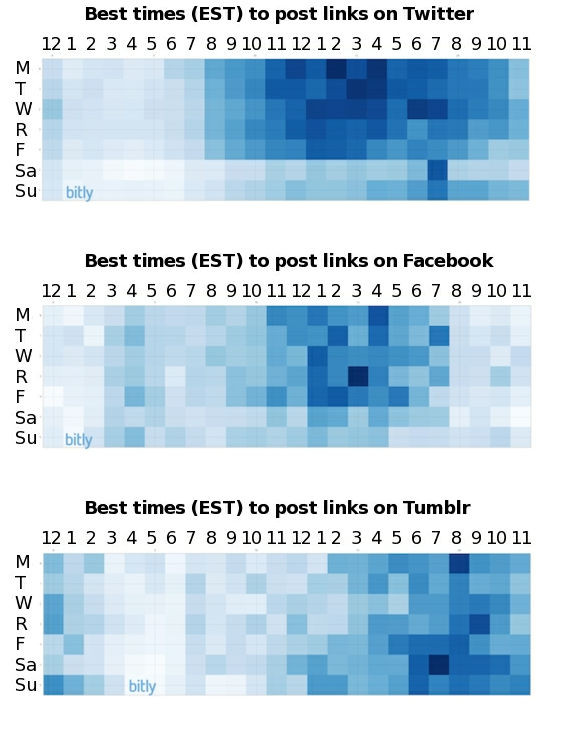Most businesses I talk to have no idea that Facebook scrubs content. In fact, on average, only 16% of fans ever see posts made by brands “for various reasons, like the number of times you log on and the number of people and brands in your network” according to Facebook.
This sums up this post for those in a hurry:
Crappy content is not worth posting on Facebook and hurts your brand in the long term. Stop it. Post your best stuff, relate it to your brand and do so when people are listening. If you are not seeing actions on the content, your strategy is broken. Change it up. Write it down. Repeat what works.
So… how do you do this? Let’s examine a few factors:
A recent report from Buddy Media finds that people are three times more likely to click on links in Facebook which include the actual URL for the brand being referred to rather than a shortener URL such as tinyURL.
If you don’t like the looks of the full URL (many sites have massively ugly pathnames to pages,) you may find it useful to use a branded shortener. Several of the shortener companies (like Bit.ly) allow you to do DNS tricks to point your own shortener domain at your longer site urls. Or your can roll your own in PHP or WordPress. There are some solid commercial ones, but having your own is a pretty smart idea given that 61% of public URL shorteners are dead (along with the links they used to service!) The custom shorteners also offer nice analytics which will allow you to quickly determine the best times and days for your own posts.
What about time to post?
Ultimately you will want to determine your best time of day. What’s a good starting point for posting? Well, it makes sense to just ask the URL shorteners for some aggregate statistics. (these are from bit.ly.)
Buddy Media does publish a few hints from their own data about best times to post by sector. Your mileage may vary.
Entertainment Industry: Don’t Overlook the Weekend.
Media Industry: Avoid the Monday Noise.
Retail Industry: Take a Look at Sunday, Think Twice before Posting on Friday
Automotive Industry: Sunday Is Your Friend.
Business and Finance Industry: Engagement Peaks Midweek.
Fashion Industry: Engagement Peaks on Thursday.
Food and Beverage Industry: Engagement High Midweek and Saturday
Healthcare and Beauty Industry: Look at Thursday.
Sports Industry: Post More on Sunday.
Travel and Hospitality Industry: Look Towards the End of the Week.
That guidance seems solid, but what about the other advice saying that customers are less apt to click on posts which come from scheduling apps, such as Hootsuite?
Applum found that posting via one of the top ten third-party APIs gave you an average of 88% fewer comments and likes, compared to posting directly to Facebook yourself.
Wow. The theory is that Facebook is discriminating against these types of apps in their feed algorithm. Other theories include users turning off third party apps from their feed at a higher rate than is generally known. In any case, that’s a huge loss of clicks. Looks like we better just set an alarm, log in and post things by hand!
[UPDATE: Facebook is now rolling out scheduled posts as a normal part of the administrative interface. The issues with 3rd party posting software appear to be going away.]
But what to post? Well, Facebook only wants your best stuff
Facebook’s Edgerank Is Watching
Facebook doesn’t show every post the same way, and very few businesses know this. It has a sophisticated algorithm “Edgerank” which sorts and filters stories shown on your friends’ / fans’ walls. Let’s take a shallow dive into Edgerank – it’s not that hard.
Shallow Dive into Edgerank
An “Edge” is an action on Facebook. Posts, Status changes, comments, shares, likes and tagging are all “Edges.” Facebook uses three variables in determining how well things that you post get spread around. Affinity, Weight and Time Decay. Affinity is the measurement of how “close” the relationship is between the user and the Page/Brand. All types of engagements (Likes, Shares, Comments) increase the Affinity score. Weight assigns a multiplier to each type of action a user can do inside of Facebook. Comments get higher weight (more work) and Likes get smaller levels (easier.) Shares are the highest weighted engagement of all because they involve commenting as well as taking a risk that your followers/friends will not like what you’ve posted. Finally, “Time Decay” is just a measurement of how long the “Edge” has been alive. Old content tends to go away at a rate defined by how popular it is. Low popularity content vanishes quickly.
The key here is that Edgerank has “tipping points” and you want to be sure that your posts come in “above” those points. An unpopular post is not worth doing because it will decay very fast and nobody will see it. It’s worth it to create fantastic content on your Facebook page, and post it at the best possible time.
For Geeks:
e = the edge (Facebook action)
u = affinity for the edge (closeness of the relationship)
w = weight of the edge (“commitment” required to take action)
d = decay rate of the edge (how fast old stuff is removed.)
So until Facebook provides scheduled posting natively (unlikely except with sponsored posts,) you’re still going to have to figure out the solution that works best for you. First step is to measure, so get out those slide rules.
subway photo: Michael Mandiberg










